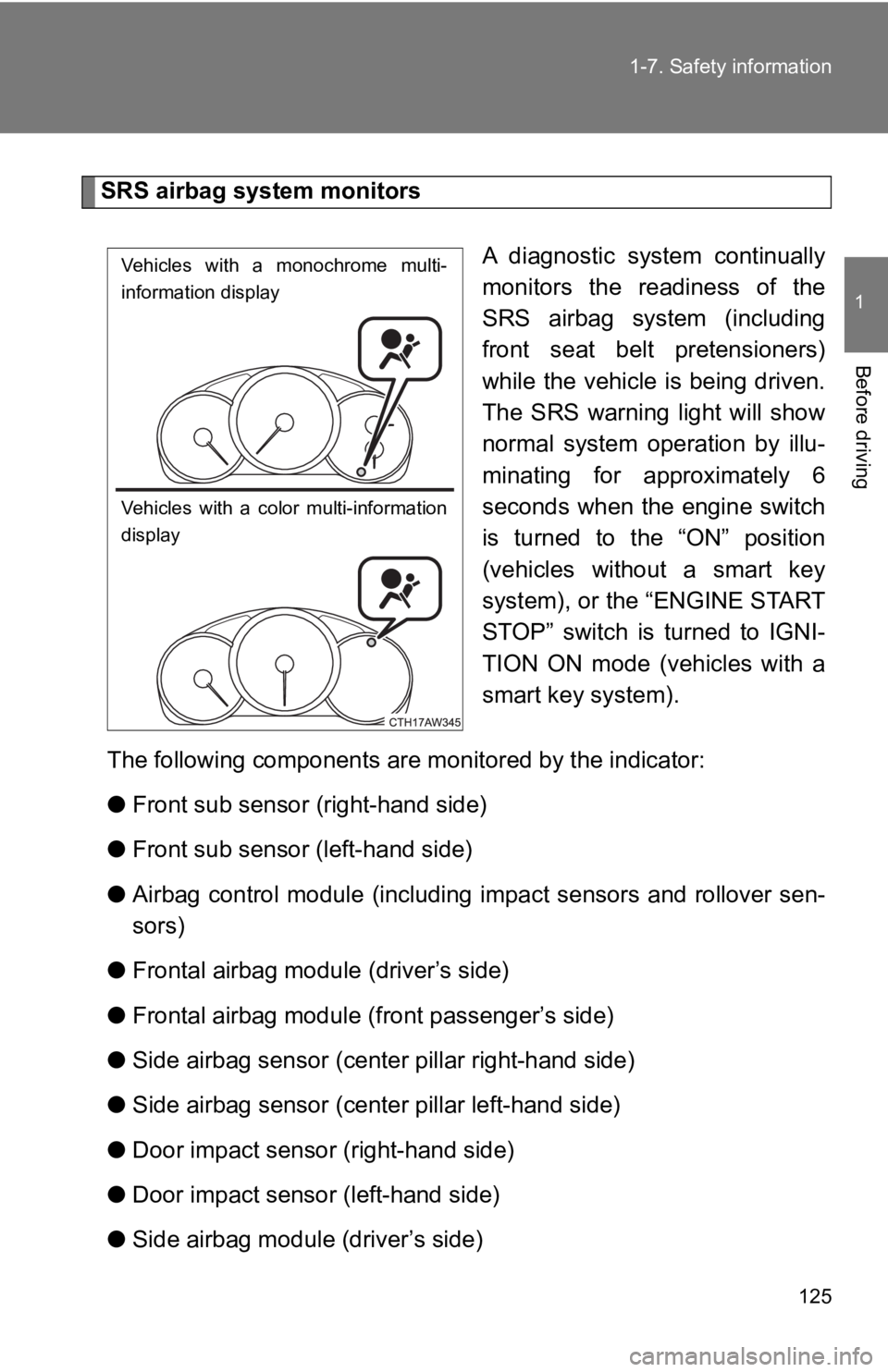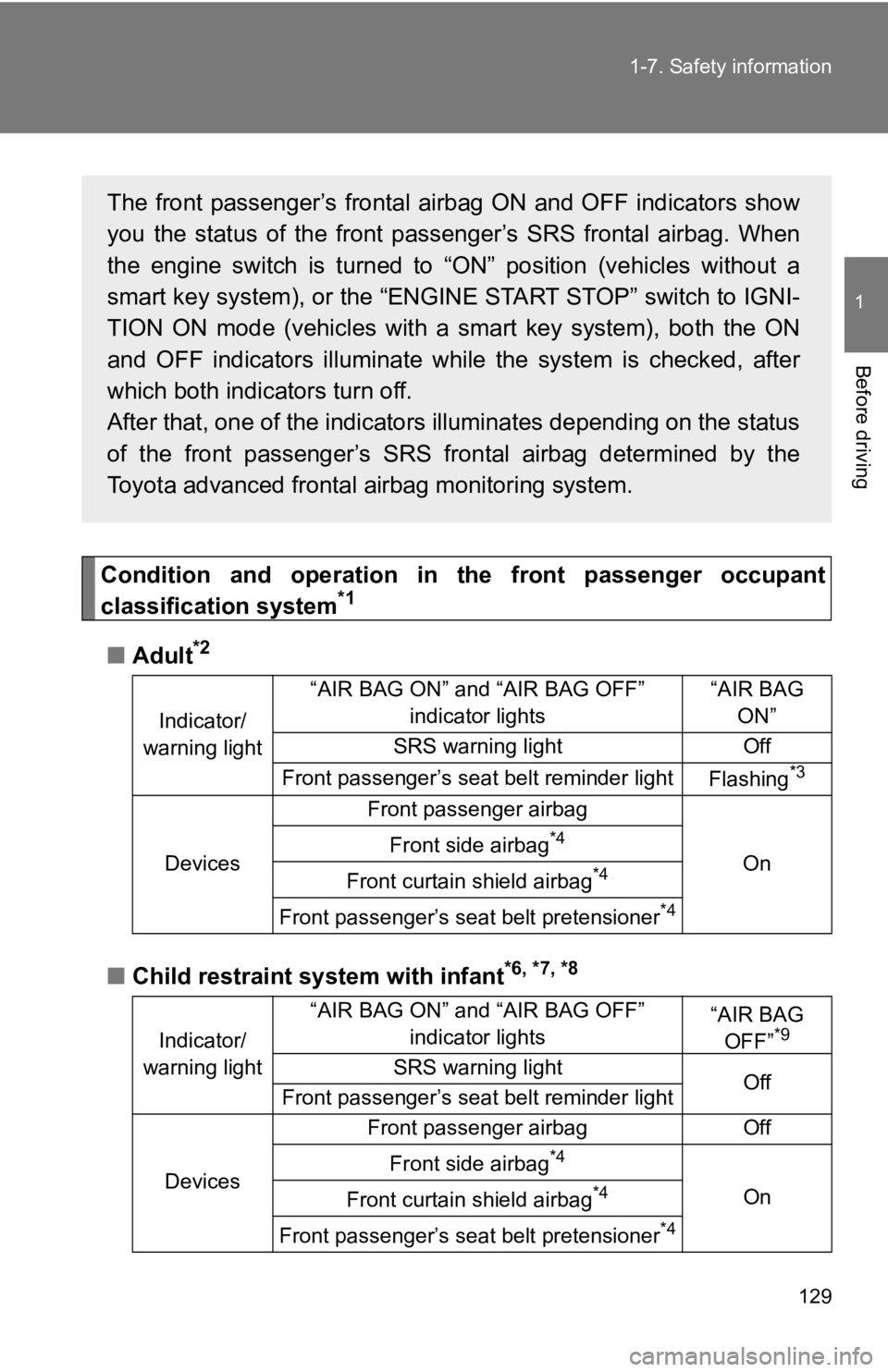2018 TOYOTA 86 key
[x] Cancel search: keyPage 102 of 532

102 1-7. Safety information
■If the passenger’s frontal airbag OFF indicator illuminates and the ON
indicator turns off even when the front passenger’s seat is occ upied by
an adult
This can be caused by the adult incorrectly sitting in the fron t passenger’s
seat. Turn the engine switch to the “LOCK” position (vehicles w ithout a smart
key system), or turn the “ENGINE START STOP” switch off (vehicl es with a
smart key system). Ask the front passenger to set the seatback to the
upright position, sit up straight in the center of the seat cushion, correctly
fasten the seat belt, position his/her legs out forward, and ad just the seat to
the rearmost position. Turn the engine switch to the “ON” posit ion (vehicles
without a smart key system), or turn the “ENGINE START STOP” sw itch to
IGNITION ON mode (vehicles with a smart key system). If the OFF indicator
remains illuminated while the ON indicator remains off, take th e following
actions.
● Vehicles without a smart key system:
Turn the engine switch to the “LOCK” position.
Vehicles with a smart key system:
Turn the “ENGINE START STOP” switch off.
● Make sure that the front passenger does not use a blanket, seat cushion,
seat cover, seat heater or massager, etc.
● If wearing excessive layers of clothing, the front passenger should
remove any unnecessary items before sitting in the front passenger’s
seat, or should sit in a rear seat.
● Next, turn the engine switch to the “ON” position and wait 6 se conds to
allow the system to complete self-checking. Following the syste m check,
both indicators turn off for 2 seconds. Now, the ON indicator should illu-
minate while the OFF indicator remains off.
If the OFF indicator still remains illuminated while the ON ind icator remains
off, ask the occupant to move to the rear seat and immediately contact your
Toyota dealer for an inspection.
Page 104 of 532

104 1-7. Safety information
The SRS airbag can function only when the engine switch is in the “ON”
position (vehicles without a smart key system) or when the “ENGINE START
STOP” switch is in IGNITION ON mode (vehicles with a smart key system).
The Toyota advanced frontal airbag system is designed to determ ine the
activation or deactivation condition of the front passenger’s S RS frontal air-
bag depending on the characteristic of the item(s) or person on the front
passenger’s seat monitored by the front passenger’s occupant cl assification
system sensor. For this reason, only the driver’s SRS frontal a irbag may
deploy in the event of a collision, but this does not mean fail ure of the sys-
tem.
If the front sub sensors and the impact sensors in the airbag c ontrol module
detect a predetermined amount of force during a frontal collisi on, the control
module sends signals to the airbag module(s) (only driver’s mod ule or both
driver’s and front passenger’s modules) instructing the module( s) to inflate
the SRS frontal airbag(s).
The driver’s and front passenger’s SRS frontal airbags use dual stage infla-
tors. The two inflators of each airbag are triggered either seq uentially or
simultaneously, depending on the severity of impact, in the cas e of the
driver’s SRS frontal airbag and depending on the severity of im pact and the
characteristic of the item(s) or person on the seat in the case of the front
passenger’s SRS frontal airbag.
After deployment, the SRS airbag immediately starts to deflate so that the
driver’s vision is not obstructed. The time required from detec ting impact to
the deflation of the SRS airbag after deployment is shorter tha n the blink of
an eye.
Both when only the driver’s SRS frontal airbag deploys and the driver’s and
front passenger’s SRS frontal airbags deploy, the driver’s and front passen-
ger’s seat belt pretensioners operate at the same time.
Although it is highly unlikely that the SRS airbag would activa te in a non-
accident situation, should it occur, the SRS airbag will deflat e quickly, not
obscuring vision and will not interfere with the driver's abili ty to maintain con-
trol of the vehicle.
When the SRS airbag deploys, a sudden, fairly loud inflation no ise will be
heard and some smoke will be released. These occurrences are a normal
result of the deployment. This smoke does not indicate a fire i n the vehicle.
Page 111 of 532

111
1-7. Safety information
1
Before driving
■
Operation
The SRS side airbag and SRS curtain shield airbag can function only when
the engine switch is in the “ON” position (vehicles without a s mart key sys-
tem) or when the “ENGINE START ST OP” switch is in IGNITION ON mode
(vehicles with a smart key system).
The driver’s and front passenger’s SRS side airbags and SRS cur tain shield
airbags deploy independently of each other since each has its o wn impact
sensor. Therefore, they may not both deploy in the same acciden t. Also, the
SRS side airbag and SRS curtain shield airbag deploys independe ntly of the
driver’s and front passenger’s SRS front airbags in the steerin g wheel and
instrument panel.
A rollover sensor is also located inside the airbag control mod ule.
An impact sensor, which senses impact force, is located in each of the left
and right center pillars, doors and rear wheel houses. Another impact sen-
sor, which also senses impact force, is located under the center of the rear
seats.
If the impact sensor that is located under the center of the re ar seats and
one of the center pillar impact sensors or door impact sensors together
sense an impact force above a predetermined level in a side col lision, the
control module causes both the SRS side airbag and curtain shield airbag on
the impacted side to inflate regardless of whether the rear whe el house
impact sensor on the same side senses an impact.
If the impact sensor that is located under the center of the re ar seats and
one of the rear wheel house impact sensors together sense an im pact force
above a predetermined level, the control module causes only the SRS cur-
tain shield airbag on the impacted side to inflate.
If the rollover sensor detects rollover of the vehicle, the control module
inflates the SRS curtain shield airbags. At this time, the driver's and front
passenger’s seat belt pretensioners also operate at the same ti me.
Page 125 of 532

125
1-7. Safety information
1
Before driving
SRS airbag system monitors
A diagnostic system continually
monitors the readiness of the
SRS airbag system (including
front seat belt pretensioners)
while the vehicle is being driven.
The SRS warning light will show
normal system operation by illu-
minating for approximately 6
seconds when the engine switch
is turned to the “ON” position
(vehicles without a smart key
system), or the “ENGINE START
STOP” switch is turned to IGNI-
TION ON mode (vehicles with a
smart key system).
The following components are mo nitored by the indicator:
● Front sub sensor (right-hand side)
● Front sub sensor (left-hand side)
● Airbag control module (including impact sensors and rollover se n-
sors)
● Frontal airbag modu le (driver’s side)
● Frontal airbag module ( front passenger’s side)
● Side airbag sensor (center pillar right-hand side)
● Side airbag sensor (center pillar left-hand side)
● Door impact sensor (right-hand side)
● Door impact sensor (left-hand side)
● Side airbag module (driver’s side)
Vehicles with a monochrome multi-
information display
Vehicles with a color multi-information
display
Page 127 of 532

127
1-7. Safety information
1
Before driving
WARNING
■
SRS warning light
If the warning light exhibits any of the following conditions, there may be a
malfunction in the seat belt pretensioners, SRS airbag system a nd/or front
passenger occupant classification system. Immediately take your vehicle to
your nearest Toyota dealer to have the system checked. Unless c hecked
and properly repaired, the seat belt pretensioners, SRS airbag and/or front
passenger occupant classification system will not operate prope rly in the
event of a collision, which may increase the risk of death or s erious injury.
● Flashing or flickering of the warning light
● No illumination of the warning light when the engine switch is first turned to
the “ON” position (vehicles without a smart key system), or the “ENGINE
START STOP” switch is turned to IGNITION ON mode (vehicles with a
smart key system).
● Continuous illumination of the warning light
● Illumination of the warning light while driving
Page 129 of 532

129
1-7. Safety information
1
Before driving
Condition and operation in t
he front passenger occupant
classification system*1
■ Adult*2
■Child restraint system with infant*6, *7, *8
Indicator/
warning light “AIR BAG ON” and “AIR BAG OFF”
indicator lights “AIR BAG
ON”
SRS warning light Off
Front passenger’s seat belt reminder light Flashing
*3
DevicesFront passenger airbag
On
Front side airbag
*4
Front curtain shield airbag*4
Front passenger’s seat belt pretensioner*4
Indicator/
warning light “AIR BAG ON” and “AIR BAG OFF”
indicator lights “AIR BAG
OFF”*9
SRS warning light Off
Front passenger’s seat belt reminder light
Devices Front passenger airbag
Off
Front side airbag
*4
On
Front curtain shield airbag*4
Front passenger’s seat belt pretensioner*4
The front passenger’s frontal airbag ON and OFF indicators show
you the status of the front pass enger’s SRS frontal airbag. Whe n
the engine switch is turned to “ ON” position (vehicles without a
smart key system), or the “ENGINE START STOP” switch to IGNI-
TION ON mode (vehicles with a smart key system), both the ON
and OFF indicators illuminate whil e the system is checked, after
which both indicators turn off.
After that, one of the indicators illuminates depending on the status
of the front passenger’s SRS frontal airbag determined by the
Toyota advanced frontal airbag monitoring system.
Page 132 of 532

132 1-7. Safety information
If the passenger’s frontal airbag OFF indicator illuminates and the ON indicator
turns off even when the front passenger’s seat is occupied by a n adult
This can be caused by an adult incorrectly sitting in the front passen-
ger’s seat. Perform the following.
Vehicles without a smart key system:
The engine switch is turned to the “LOCK” position.
Vehicles with a smart key system:
Turn the “ENGINE START STOP” switch off.
Ask the front passenger to set the seatback to the upright
position, sit up straight in the center of the seat cushion, co r-
rectly wear the seat belt, position his/her legs out forward, a nd
adjust the seat to the rearmost position.
Vehicles without a smart key system:
The engine switch is tur ned to the “ON” position.
Vehicles with a smart key system:
Turn the “ENGINE START STOP” switch to IGNITION ON
mode.
If the OFF indicator remains illuminated while the ON indicator
remains off, perform the following.
• Vehicles without a smart key system: The engine switch is turned to the “LOCK” position.
Vehicles with a smart key system:
Turn the “ENGINE START STOP” switch off.
• Make sure that the front passenger is not using a blanket, seat cushion, seat cove r or seat heater, etc.
• If wearing excessive layers o f clothing, the front passenger
should remove any unnecessary items before sitting in the
front passenger seat, or s hould sit in a rear seat.
STEP 1
STEP 2
STEP 3
STEP 4
Page 133 of 532

133
1-7. Safety information
1
Before driving
The engine switch is turned to the “ON” position (vehicles
without a smart key system), or the “ENGINE START STOP”
switch to IGNITION ON mode (vehicles with a smart key sys-
tem). After the self-check is
performed, the ON indicator
should illuminate while the OFF indicator remains off. If the
OFF indicator still remains illumi nated while the ON indicator
remains off, ask the occupant to move to the rear seat and
immediately contact your Toyo ta dealer for an inspection.STEP 5